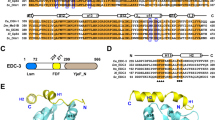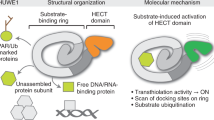Abstract
The RNase XRN2 is essential in RNA metabolism. In Caenorhabditis elegans, XRN2 functions with PAXT-1, which shares a putative XRN2-binding domain (XTBD) with otherwise unrelated mammalian proteins. Here, we characterize the structure and function of an XTBD–XRN2 complex. Although XTBD stably interconnects two XRN2 domains through numerous interacting residues, mutation of a single critical residue suffices to disrupt XTBD–XRN2 complexes in vitro and to recapitulate paxt-1–null mutant phenotypes in vivo. Demonstrating conservation of function, vertebrate XTBD-containing proteins bind XRN2 in vitro, and human CDKN2AIPNL (HsC2AIL) can substitute for PAXT-1 in vivo. In vertebrates, which express three distinct XTBD-containing proteins, XRN2 may partition into distinct stable heterodimeric complexes, which probably differ in subcellular localization or function. In C. elegans, complex formation with PAXT-1, the sole XTBD protein, serves to preserve the stability of XRN2 in the absence of substrate.
This is a preview of subscription content, access via your institution
Access options
Subscribe to this journal
Receive 12 print issues and online access
$189.00 per year
only $15.75 per issue
Buy this article
- Purchase on Springer Link
- Instant access to full article PDF
Prices may be subject to local taxes which are calculated during checkout




Similar content being viewed by others
References
Petfalski, E., Dandekar, T., Henry, Y. & Tollervey, D. Processing of the precursors to small nucleolar RNAs and rRNAs requires common components. Mol. Cell. Biol. 18, 1181–1189 (1998).
Wang, M. & Pestov, D.G. 5′-end surveillance by Xrn2 acts as a shared mechanism for mammalian pre-rRNA maturation and decay. Nucleic Acids Res. 39, 1811–1822 (2011).
Couvillion, M.T., Bounova, G., Purdom, E., Speed, T.P. & Collins, K. A Tetrahymena Piwi bound to mature tRNA 3′ fragments activates the exonuclease Xrn2 for RNA processing in the nucleus. Mol. Cell 48, 509–520 (2012).
Geerlings, T.H., Vos, J.C. & Raué, H.A. The final step in the formation of 25S rRNA in Saccharomyces cerevisiae is performed by 5′→3′ exonucleases. RNA 6, 1698–1703 (2000).
Chanfreau, G., Rotondo, G., Legrain, P. & Jacquier, A. Processing of a dicistronic small nucleolar RNA precursor by the RNA endonuclease Rnt1. EMBO J. 17, 3726–3737 (1998).
Zakrzewska-Placzek, M., Souret, F.F., Sobczyk, G.J., Green, P.J. & Kufel, J. Arabidopsis thaliana XRN2 is required for primary cleavage in the pre-ribosomal RNA. Nucleic Acids Res. 38, 4487–4502 (2010).
West, S., Gromak, N. & Proudfoot, N.J. Human 5′ → 3′ exonuclease Xrn2 promotes transcription termination at co-transcriptional cleavage sites. Nature 432, 522–525 (2004).
Kim, M. et al. The yeast Rat1 exonuclease promotes transcription termination by RNA polymerase II. Nature 432, 517–522 (2004).
Davidson, L., Kerr, A. & West, S. Co-transcriptional degradation of aberrant pre-mRNA by Xrn2. EMBO J. 31, 2566–2578 (2012).
Chernyakov, I., Whipple, J.M., Kotelawala, L., Grayhack, E.J. & Phizicky, E.M. Degradation of several hypomodified mature tRNA species in Saccharomyces cerevisiae is mediated by Met22 and the 5′-3′ exonucleases Rat1 and Xrn1. Genes Dev. 22, 1369–1380 (2008).
Chatterjee, S. & Großhans, H. Active turnover modulates mature microRNA activity in Caenorhabditis elegans. Nature 461, 546–549 (2009).
Miki, T.S. & Großhans, H. The multifunctional RNase XRN2. Biochem. Soc. Trans. 41, 825–830 (2013).
Nagarajan, V.K., Jones, C.I., Newbury, S.F. & Green, P.J. XRN 5′→3′ exoribonucleases: structure, mechanisms and functions. Biochim. Biophys. Acta 1829, 590–603 (2013).
Amberg, D.C., Goldstein, A.L. & Cole, C.N. Isolation and characterization of RAT1: an essential gene of Saccharomyces cerevisiae required for the efficient nucleocytoplasmic trafficking of mRNA. Genes Dev. 6, 1173–1189 (1992).
Miki, T.S., Rüegger, S., Gaidatzis, D., Stadler, M.B. & Großhans, H. Engineering of a conditional allele reveals multiple roles of XRN2 in Caenorhabditis elegans development and substrate specificity in microRNA turnover. Nucleic Acids Res. 42, 4056–4067 (2014).
Parker, R. & Sheth, U. P bodies and the control of mRNA translation and degradation. Mol. Cell 25, 635–646 (2007).
Kenna, M., Stevens, A., McCammon, M. & Douglas, M.G. An essential yeast gene with homology to the exonuclease-encoding XRN1/KEM1 gene also encodes a protein with exoribonuclease activity. Mol. Cell. Biol. 13, 341–350 (1993).
Stevens, A. & Poole, T.L. 5′-exonuclease-2 of Saccharomyces cerevisiae: purification and features of ribonuclease activity with comparison to 5′-exonuclease-1. J. Biol. Chem. 270, 16063–16069 (1995).
Poole, T.L. & Stevens, A. Comparison of features of the RNase activity of 5′-exonuclease-1 and 5′-exonuclease-2 of Saccharomyces cerevisiae. Nucleic Acids Symp. Ser. 79–81 (1995).
Jinek, M., Coyle, S.M. & Doudna, J.A. Coupled 5′ nucleotide recognition and processivity in Xrn1-mediated mRNA decay. Mol. Cell 41, 600–608 (2011).
Xiang, S. et al. Structure and function of the 5′→3′ exoribonuclease Rat1 and its activating partner Rai1. Nature 458, 784–788 (2009).
Xue, Y. et al. Saccharomyces cerevisiae RAI1 (YGL246c) is homologous to human DOM3Z and encodes a protein that binds the nuclear exoribonuclease Rat1p. Mol. Cell. Biol. 20, 4006–4015 (2000).
Miki, T.S., Richter, H., Rüegger, S. & Großhans, H. PAXT-1 promotes XRN2 activity by stabilizing it through a conserved domain. Mol. Cell 53, 351–360 (2014).
Brannan, K. et al. mRNA decapping factors and the exonuclease Xrn2 function in widespread premature termination of RNA polymerase II transcription. Mol. Cell 46, 311–324 (2012).
Close, P. et al. DBIRD complex integrates alternative mRNA splicing with RNA polymerase II transcript elongation. Nature 484, 386–389 (2012).
Söding, J., Biegert, A. & Lupas, A.N. The HHpred interactive server for protein homology detection and structure prediction. Nucleic Acids Res. 33, W244–W248 (2005).
Buchan, D.W., Minneci, F., Nugent, T.C., Bryson, K. & Jones, D.T. Scalable web services for the PSIPRED Protein Analysis Workbench. Nucleic Acids Res. 41, W349–W357 (2013).
Linding, R. et al. Protein disorder prediction: implications for structural proteomics. Structure 11, 1453–1459 (2003).
Chang, J.H., Xiang, S., Xiang, K., Manley, J.L. & Tong, L. Structural and biochemical studies of the 5′→3′ exoribonuclease Xrn1. Nat. Struct. Mol. Biol. 18, 270–276 (2011).
Holm, L. & Rosenström, P. Dali server: conservation mapping in 3D. Nucleic Acids Res. 38, W545–W549 (2010).
Krissinel, E. & Henrick, K. Inference of macromolecular assemblies from crystalline state. J. Mol. Biol. 372, 774–797 (2007).
Duarte, J.M., Srebniak, A., Schärer, M.A. & Capitani, G. Protein interface classification by evolutionary analysis. BMC Bioinformatics 13, 334 (2012).
Ashkenazy, H., Erez, E., Martz, E., Pupko, T. & Ben-Tal, N. ConSurf 2010: calculating evolutionary conservation in sequence and structure of proteins and nucleic acids. Nucleic Acids Res. 38, W529–W533 (2010).
Celniker, G. et al. ConSurf: using evolutionary data to raise testable hypotheses about protein function. Isr. J. Chem. 53, 199–206 (2013).
Arribere, J.A. et al. Efficient marker-free recovery of custom genetic modifications with CRISPR/Cas9 in Caenorhabditis elegans. Genetics 198, 837–846 (2014).
Dickinson, D.J., Ward, J.D., Reiner, D.J. & Goldstein, B. Engineering the Caenorhabditis elegans genome using Cas9-triggered homologous recombination. Nat. Methods 10, 1028–1034 (2013).
Cheung, C.T., Singh, R., Kalra, R.S., Kaul, S.C. & Wadhwa, R. Collaborator of ARF (CARF) regulates proliferative fate of human cells by dose-dependent regulation of DNA damage signaling. J. Biol. Chem. 289, 18258–18269 (2014).
Hasan, M.K. et al. CARF is a novel protein that cooperates with mouse p19ARF (human p14ARF) in activating p53. J. Biol. Chem. 277, 37765–37770 (2002).
Hasan, M.K. et al. Alternative reading frame protein (ARF)-independent function of CARF (collaborator of ARF) involves its interactions with p53: evidence for a novel p53-activation pathway and its negative feedback control. Biochem. J. 380, 605–610 (2004).
Querol, E., Perez-Pons, J.A. & Mozo-Villarias, A. Analysis of protein conformational characteristics related to thermostability. Protein Eng. 9, 265–271 (1996).
Feng, X. et al. Identification of a negative response element in the human inducible nitric-oxide synthase (hiNOS) promoter: the role of NF-kappa B-repressing factor (NRF) in basal repression of the hiNOS gene. Proc. Natl. Acad. Sci. USA 99, 14212–14217 (2002).
Uhlén, M. et al. Proteomics: tissue-based map of the human proteome. Science 347, 1260419 (2015).
Rother, S. et al. NF-κB-repressing factor phosphorylation regulates transcription elongation via its interactions with 5′→3′ exoribonuclease 2 and negative elongation factor. FASEB J. doi:10.1096/fj.15-270256 (4 September 2015).
Vieille, C. & Zeikus, G.J. Hyperthermophilic enzymes: sources, uses, and molecular mechanisms for thermostability. Microbiol. Mol. Biol. Rev. 65, 1–43 (2001).
Ghaemmaghami, S. & Oas, T.G. Quantitative protein stability measurement in vivo. Nat. Struct. Biol. 8, 879–882 (2001).
McLendon, G. & Radany, E. Is protein turnover thermodynamically controlled? J. Biol. Chem. 253, 6335–6337 (1978).
Parsell, D.A. & Sauer, R.T. The structural stability of a protein is an important determinant of its proteolytic susceptibility in Escherichia coli. J. Biol. Chem. 264, 7590–7595 (1989).
Kumar, S., Tsai, C.J. & Nussinov, R. Factors enhancing protein thermostability. Protein Eng. 13, 179–191 (2000).
Wheeler, T.J., Clements, J. & Finn, R.D. Skylign: a tool for creating informative, interactive logos representing sequence alignments and profile hidden Markov models. BMC Bioinformatics 15, 7 (2014).
Blommel, P.G. & Fox, B.G. A combined approach to improving large-scale production of tobacco etch virus protease. Protein Expr. Purif. 55, 53–68 (2007).
Kabsch, W. XDS. Acta Crystallogr. D Biol. Crystallogr. 66, 125–132 (2010).
McCoy, A.J. et al. Phaser crystallographic software. J. Appl. Crystallogr. 40, 658–674 (2007).
Cowtan, K. The Buccaneer software for automated model building. 1. Tracing protein chains. Acta Crystallogr. D Biol. Crystallogr. 62, 1002–1011 (2006).
Afonine, P.V. et al. Towards automated crystallographic structure refinement with phenix.refine. Acta Crystallogr. D Biol. Crystallogr. 68, 352–367 (2012).
Emsley, P., Lohkamp, B., Scott, W.G. & Cowtan, K. Features and development of Coot. Acta Crystallogr. D Biol. Crystallogr. 66, 486–501 (2010).
Sinturel, F. et al. Real-time fluorescence detection of exoribonucleases. RNA 15, 2057–2062 (2009).
Brenner, S. The genetics of Caenorhabditis elegans. Genetics 77, 71–94 (1974).
Gibson, D.G. et al. Enzymatic assembly of DNA molecules up to several hundred kilobases. Nat. Methods 6, 343–345 (2009).
Friedland, A.E. et al. Heritable genome editing in C. elegans via a CRISPR-Cas9 system. Nat. Methods 10, 741–743 (2013).
Katic, I. & Großhans, H. Targeted heritable mutation and gene conversion by Cas9-CRISPR in Caenorhabditis elegans. Genetics 195, 1173–1176 (2013).
Katic, I., Xu, L. & Ciosk, R. CRISPR/Cas9 genome editing in Caenorhabditis elegans: evaluation of templates for homology-mediated repair and knock-ins by homology-independent DNA repair. G3 (Bethesda) 5, 1649–1656 (2015).
Frøkjaer-Jensen, C. et al. Single-copy insertion of transgenes in Caenorhabditis elegans. Nat. Genet. 40, 1375–1383 (2008).
Frøkjær-Jensen, C., Davis, M.W., Ailion, M. & Jorgensen, E.M. Improved Mos1-mediated transgenesis in C. elegans. Nat. Methods 9, 117–118 (2012).
de la Mata, M. et al. Potent degradation of neuronal miRNAs induced by highly complementary targets. EMBO Rep. 16, 500–511 (2015).
Acknowledgements
We thank J. Keusch for technical support, D. Hess for mass spectrometry analysis, M. de la Mata for assistance with cell transfections, M. Zou (Friedrich Miescher Institute for Biomedical Research) for zebrafish lysate and J.A. Chao and N. Thomä for critical comments on the manuscript. We are grateful to the staff of the Swiss Light Source, Paul Scherrer Institute, Villingen, where parts of the experiments were performed. The research leading to these results received funding from the European Union Seventh Framework Programme (FP7/2007-2013) under grant agreement number 241985 (European Research Council 'miRTurn'; to H. Großhans), the Swiss National Science Foundation (SNF 31003A_143313; to H. Großhans) and the Novartis Research Foundation through the Friedrich Miescher Institute (to I.K., H. Gut and H. Großhans).
Author information
Authors and Affiliations
Contributions
H.R. and H. Großhans designed research. H.R. designed and performed in vitro and in vivo experiments. H. Gut and H.R. performed crystallographic structure determination and analyses. I.K. performed clustered regularly interspaced short palindromic repeats (CRISPR) procedures, injected worms and assisted in crossing worm lines. H.R., H. Großhans and H. Gut wrote the manuscript. All authors edited the manuscript.
Corresponding author
Ethics declarations
Competing interests
The authors declare no competing financial interests.
Integrated supplementary information
Supplementary Figure 1 Complexes of XRNs and their binding partners.
(a) A Coomassie-stained SDS-PAGE gel of PAXT-1 truncation mutants (asterisks) co-expressed with XRN2 (arrowhead). All mutant proteins bind XRN2 to similar extents. For each PAXT-1 mutant, two clones were expressed and pulled on their His6-tag to co-elute XRN2. (b) Structural representation of the XTBD – XRN2 complex highlighting the tower domain and the PBS-protruding loop. XTBD and the remaining parts of XRN2 are in light colors. (c) Structural representation of XTBD bound to XRN2, with helices and loops indicated. (d) Superposition of C. elegans XTBD – XRN2 complex and S. pombe Rai1p – Rat1p complex reveals that XTBD and Rai1p bind to distinct sites on XRN2. (e) Superposition of C. elegans XTBD – XRN2 complex and D. melanogaster XRN1 reveals potential structural clashes of XRN1 with XTBD (dashed red circles in close-up, top).
Supplementary Figure 2 Characterization of XRN2-XTBD interaction.
(a) SEC-MALS analysis of the XTBD –XRN2ΔZLC complex. The blue line indicates the gel filtration elution profile, monitored by UV light absorption at 280 nm. Red dots indicate molar mass values under the peak. The measured molar mass for the complex (80.9 kDa) was calculated over peak fractions covering the elution volume 14.8 ml – 16.3 ml, which represent a completely monodisperse sample (polydispersity = 1.000). (b) Close-up of the binding interface of XTBD (yellow) and XRN2ΔZLC (cyan/gray). Key residues mediating interaction are represented as sticks with oxygens and nitrogens colored in red and blue (atom colors), respectively. (c) Zoom-in on residue Cys54, which forms hydrophobic interactions with Pro656 and Cα / Cβ of Phe659 as well as a weak hydrogen bond with Leu675. (d) Biological replicate of the western blot shown in Fig. 2g, detecting XRN2 and PAXT-1 from worms grown at 26°C. (e), (f) Small scale expression of His6-PAXT-1, -PAXT-1_Y56A and- PAXT-1_C54G. (e) For each construct, cleared lysate, unbound and Ni-NTA pull-down fraction were loaded. (f) Western blot using antibodies against XRN2 and PAXT-1 was performed on the cleared lysates.
Supplementary Figure 3 Homology of XTBDs and XRN2 PBS domains.
(a) A human C2AIL homology model (magenta) superimposed onto the XTBD - XRN2 complex (yellow and cyan, respectively). (b) Pfam alignment of selected XTBDs from PAXT-1 of C. elegans (Uniprot identifier Q21738) and C. briggsae (A8XFX8), respectively, and CDKN2AIP from D. rerio (F1QZX8), D. melanogaster (Q9VF83), H. sapiens (Q9NXV6), and M. musculus (Q8BI72), respectively, on which the homology model is based. The critical residue Tyr56 is found at position 104 in this alignment. (c) Alignment based on HMM-search of XRN2 PBS. Shown are representative sequences from C. elegans (Q9U299), C. briggsae (Q60SG7), D. rerio (Q802V7), D. melanogaster (Q9VM71), H. sapiens (Q9H0D6) and M. musculus (Q9DBR1) XRN2.
Supplementary Figure 4 Kinetic analysis of XRN2 and its complex.
(a) Michaelis-Menten kinetic curves of XRN2 and the PAXT-1 – XRN2 complex, respectively. XRN2’s catalytic activity was determined on a broad range of substrate concentrations using an assay based on a FAM fluorophore-coupled RNA substrate and a quencher-coupled DNA primer (Sinturel et al., RNA, 15, 2057-2062, 2009). As the substrate range accessible by this assay is limited by the dynamic range of measurable FAM fluorescence by the qPCR machine, we extended it by adding a four-fold excess of unlabeled 22 nt let-7 miRNA to the 30 nt RNA – DNA duplex. The curves are extrapolations from measurements shown in the inset. The corresponding KM values are marked as colored squares. At 0.013 s-1, the kcat of XRN2 alone is comparable to that of the PAXT-1 – XRN2 complex (table), and turnover rates are identical at substrate concentrations up to 0.5 · 10-6 M (inset). A small difference in Michaelis-Menten constants KM (table) suggests a modestly increased affinity of PAXT-1-bound XRN2 to its substrate relative to XRN2 alone. We conclude that PAXT-1 has little or no stimulatory activity on XRN2, at least under the conditions of this assay. (b) Replicates of the assay shown in Figure 4d.
Supplementary information
Supplementary Text and Figures
Supplementary Figures 1–4 (PDF 1561 kb)
Supplementary Data Set 1
Uncropped gels and blots (PDF 4789 kb)
Source data
Rights and permissions
About this article
Cite this article
Richter, H., Katic, I., Gut, H. et al. Structural basis and function of XRN2 binding by XTB domains. Nat Struct Mol Biol 23, 164–171 (2016). https://doi.org/10.1038/nsmb.3155
Received:
Accepted:
Published:
Issue Date:
DOI: https://doi.org/10.1038/nsmb.3155
This article is cited by
-
Observation of conformational changes that underlie the catalytic cycle of Xrn2
Nature Chemical Biology (2022)
-
RIF1 promotes tumor growth and cancer stem cell-like traits in NSCLC by protein phosphatase 1-mediated activation of Wnt/β-catenin signaling
Cell Death & Disease (2018)



